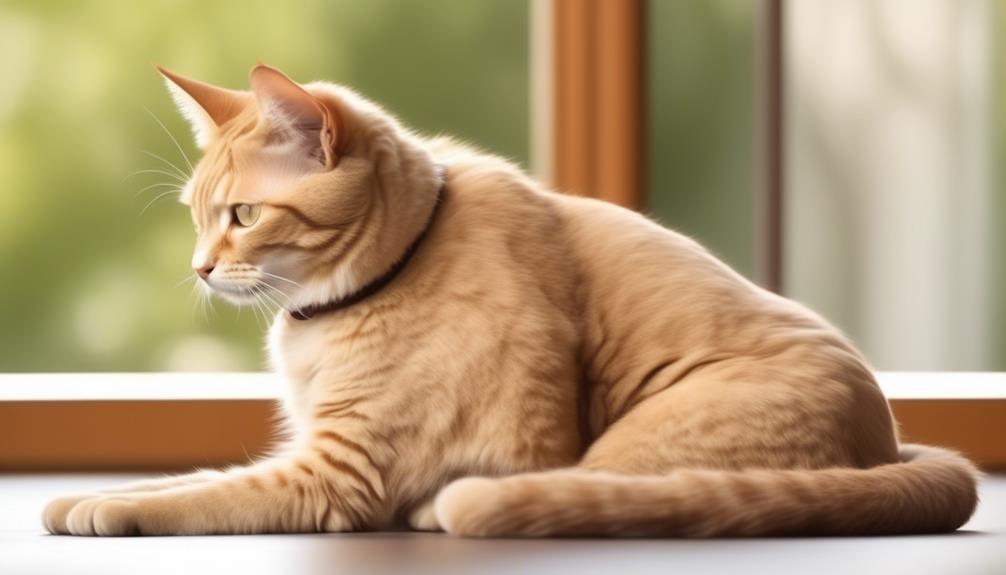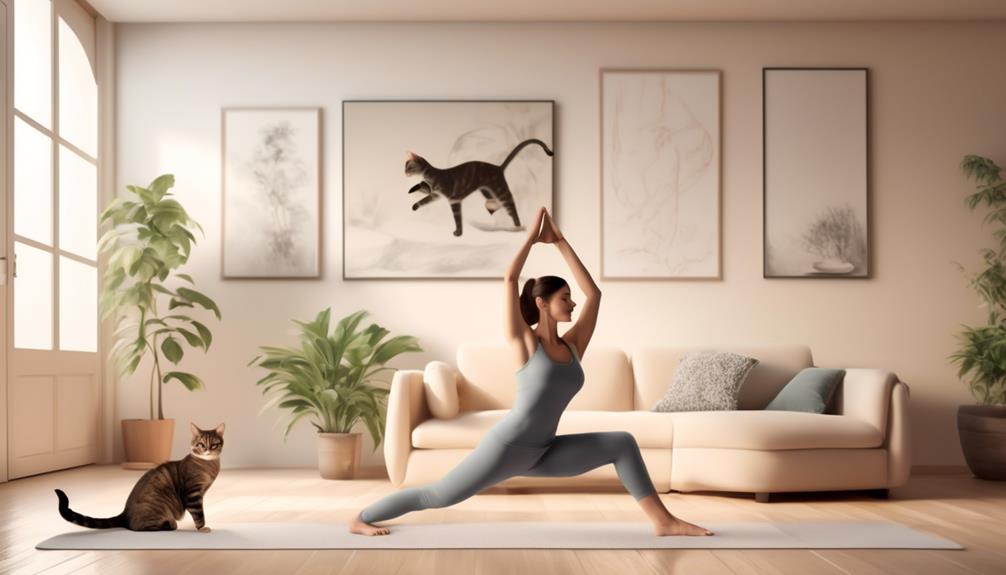How to Use Yoga to Improve Your Cat's Flexibility

Yoga can help improve your cat's flexibility and balance. It allows them to reach new heights of agility and grace.
Key Takeaways
- Cats have a highly flexible backbone with over 60 vertebrae, allowing them to arch their backs and stretch their bodies.
- Understanding cat anatomy is crucial for providing proper care and exercise.
- Regular cat yoga routines increase range of motion, muscle strength, balance, and coordination.
- Cat yoga promotes mental and emotional well-being, while also enhancing flexibility and overall well-being.
Understanding Cat Anatomy
Understanding cat anatomy is essential for cat owners to ensure the well-being and health of their feline companions. Cats have a unique anatomy that allows them to move with grace and agility. Their bodies are designed for hunting and climbing, and their muscles, joints, and bones work together to provide flexibility and strength.
One of the key aspects of cat anatomy is their skeletal structure. Cats have a highly flexible backbone with more than 60 vertebrae, compared to the 33 found in humans. This allows them to twist and turn their bodies in ways that may seem impossible to us. Their spine is also extremely flexible, allowing them to arch their backs and stretch their bodies to incredible lengths.
The flexibility benefits of cat anatomy extend beyond their spine. Cats have a specialized collarbone called the clavicle, which isn't attached to their other bones. This allows them to squeeze through tight spaces and land gracefully after jumping from high surfaces. Their shoulder joints are also highly flexible, allowing them to move their front legs in a wide range of motions.
Understanding cat anatomy is crucial for cat owners who want to keep their feline friends healthy and happy. By recognizing the unique features of their anatomy, owners can provide the proper care and exercise needed to maintain their flexibility and overall well-being.
Preparing the Yoga Space

To create a soothing environment for your cat's yoga practice, setting up the yoga space is essential. Cats, being sensitive creatures, thrive in a calming atmosphere. Here are some tips to help you create the perfect space for your feline friend:
- Choose a quiet and clutter-free area: Cats appreciate a peaceful environment, free from distractions. Find a quiet corner of your home where your cat can feel relaxed and focused during their yoga practice.
- Use soft lighting: Soft, gentle lighting can create a calming atmosphere for your cat. Avoid harsh, bright lights that may disturb their concentration. Consider using warm, dimmable lights or even candles to create a serene ambiance.
- Incorporate props effectively: Just like humans, cats can benefit from using props during their yoga practice. Provide your cat with a comfortable mat or blanket to practice on. You can also use toys or treats strategically placed to encourage stretching and movement.
Gentle Warm-up Exercises

Gently preparing your cat's body for the yoga practice is essential to ensure flexibility and prevent injuries. Just like humans, cats can benefit from stretching and warm-up exercises before engaging in any physical activity. By incorporating these gentle warm-up exercises into your cat's yoga routine, you can help improve their flexibility and overall well-being.
One of the key benefits of warming up is that it increases blood flow to the muscles, which helps to loosen them up and prepare them for movement. This can be particularly beneficial for cats, as it can help prevent muscle strains and sprains. Additionally, warming up can improve joint mobility and range of motion, allowing your cat to move more freely during their yoga practice.
To begin the warm-up, gently stroke your cat's body from head to tail, using long, sweeping motions. This helps to relax their muscles and prepare them for movement. Then, encourage your cat to stretch by gently extending their limbs, one at a time. You can also incorporate some simple stretching exercises, such as gently pulling their leg towards their chest or gently rotating their hips.
Beginner Yoga Poses for Cats

Practicing beginner yoga poses can be a beneficial and enjoyable way to enhance your cat's flexibility and overall well-being. Just like humans, cats can benefit from the gentle stretches and movements of yoga.
Here are some beginner yoga poses that you can introduce to your feline friend:
- Cat-Cow Pose: This pose helps to stretch and mobilize your cat's spine. Encourage your cat to arch their back like a Halloween cat (cat pose) and then gently round their back (cow pose). Repeat this flow several times to promote spinal flexibility.
- Downward Facing Cat: Similar to the popular Downward Facing Dog pose, this pose helps to stretch the entire body, including the hamstrings and shoulders. Have your cat stretch their front paws forward, while keeping their hind legs extended backward.
- Sphinx Pose: This pose is great for stretching the chest, abdomen, and spine. Encourage your cat to stretch their front legs forward and lift their chest off the ground, while keeping their hind legs and tail relaxed.
Intermediate Yoga Poses for Cats

As cats progress in their yoga practice, they can move on to intermediate poses that provide them with even greater flexibility and strength. These cat-friendly yoga poses are designed to gently stretch their muscles and improve their overall agility.
Cat-Friendly Yoga Poses
Cat owners who want to help their feline friends improve their flexibility can introduce them to a range of intermediate yoga poses designed specifically for cats. These poses not only enhance their flexibility but also provide numerous other benefits. Here are some cat-friendly yoga poses to try:
- Cat-Cow Stretch: This pose helps to increase spinal flexibility and release tension in the back muscles.
- Downward-Facing Cat: Similar to the downward-facing dog pose for humans, this pose stretches the entire body, improving overall flexibility.
- Purr-asana: This pose involves gentle stretching of the legs and spine, promoting relaxation and reducing stress.
To make these poses more enjoyable and accessible for your cat, consider using yoga props such as a soft mat or cushion. These props provide comfort and support, allowing your cat to fully engage in the yoga practice.
Remember to always approach cat yoga with patience, respect, and awareness of your cat's needs and limitations.
Stretching Exercises for Cats
To enhance their feline friend's flexibility, cat owners can introduce them to a variety of intermediate yoga poses tailored specifically for cats. These stretching exercises not only help cats increase their flexibility, but also provide numerous other benefits.
Incorporating yoga into a cat's routine can improve their balance, coordination, and overall physical well-being. These exercises can also help cats relieve stress, increase their focus and concentration, and promote relaxation.
Furthermore, cat yoga benefits include improved muscle tone and strength, increased joint mobility, and enhanced digestion. Some popular stretching exercises for cats include the 'cat-cow' pose, where the cat arches its back like a stretching cat and then drops its belly towards the floor, and the 'downward-facing cat' pose, where the cat stretches its front legs forward and pushes its tailbone towards the ceiling.
Flexibility Benefits for Cats
Incorporating intermediate yoga poses into a cat's routine can greatly enhance their flexibility and contribute to their overall well-being. Cat yoga benefits go beyond just physical flexibility; they also promote mental and emotional well-being.
Here are some flexibility benefits that cats can experience through regular cat yoga routines:
- Increased Range of Motion: Through stretching and holding yoga poses, cats can improve their joint flexibility and increase their range of motion, allowing them to move more freely and comfortably.
- Improved Muscle Strength: Cat yoga poses engage different muscle groups, helping to build strength and stability. This can be especially beneficial for older cats or those recovering from injuries.
- Enhanced Balance and Coordination: By practicing balancing poses, cats can improve their balance and coordination skills, which can prevent falls and accidents.
Advanced Yoga Poses for Cats

As cats become more experienced in their yoga practice, they may be ready to take on more challenging poses. These advanced yoga moves not only test their flexibility but also help them further develop their strength and balance.
From the elusive Scorpion Pose to the graceful King Pigeon Pose, these advanced poses offer a new level of physical and mental stimulation for your feline companion.
Challenging Feline Yoga Moves
Cats with a strong foundation in basic yoga poses can now take their practice to the next level with challenging feline yoga moves designed to enhance their flexibility and strength. These advanced poses require a higher level of skill and body awareness, but with practice and patience, cats can achieve impressive results.
Here are some challenging cat yoga poses to try:
- Upside-Down Kitty: This pose requires the cat to balance on its forelimbs while lifting its hind legs towards the ceiling.
- Twisted Whiskers: A twist that stretches the spine and opens the chest, this pose can help improve a cat's overall flexibility.
- Flying Feline: This pose challenges a cat's balance and core strength as it extends its body horizontally off the ground.
Remember to always provide modifications for cat yoga poses based on your feline's abilities and limitations. With proper guidance and support, cats can safely explore and benefit from these challenging poses.
Increasing Cat's Flexibility
To enhance your cat's flexibility and take their yoga practice to the next level, advanced poses can be incorporated into their routine. These challenging poses not only increase your cat's strength but also help prevent injuries. By gradually introducing these poses, you can help your feline friend become more agile and limber.
Here are three advanced yoga poses that can help increase your cat's flexibility:
| Pose | Benefits |
|---|---|
| Upward Cat | Stretches the spine and abdomen |
| Lion's Breath | Relieves tension and increases focus |
| Cat-Cow Stretch | Promotes spinal flexibility and strength |
It's important to approach these poses with caution and patience. Start by gently guiding your cat into the poses, using treats and positive reinforcement to make the experience enjoyable for them. Remember to always prioritize your cat's comfort and well-being during their yoga practice.
Advanced Poses for Cats
Enhancing your cat's yoga practice to the next level involves incorporating advanced poses that can significantly improve their flexibility and overall well-being. These advanced poses, known as feline acrobatics, require a higher level of strength and balance.
Here are three advanced flexibility techniques that can take your cat's yoga practice to new heights:
- The Cat Twist: This pose involves twisting the cat's body while keeping the spine straight. It helps to release tension in the back and improve spinal flexibility.
- The Elevated Stretch: In this pose, the cat extends its front and hind legs in opposite directions while balancing on its back legs. This helps to lengthen the muscles and improve overall flexibility.
- The Upside-Down Cat: This pose involves the cat hanging upside down from a secure surface, such as a cat tree or scratching post. It helps to stretch the spine and increase flexibility in the shoulders and hips.
Remember to always practice these advanced poses under the guidance of a trained professional to ensure your cat's safety and well-being.
Incorporating Yoga Into Your Cat's Routine

One way to incorporate yoga into your cat's routine is by gradually introducing gentle stretches and movements. Cats, like humans, can benefit from the practice of yoga in many ways. It can improve their flexibility, increase their strength, and help them relax. However, it's important to approach cat yoga with caution and respect for your feline friend's limits and preferences.
When introducing yoga to your cat, start with short sessions and observe their response. Some cats may be more receptive to stretching and movement, while others may need more time to adjust. Here are some tips for introducing yoga to your cat:
- Create a calm environment: Find a quiet space where your cat feels comfortable and safe. Remove any distractions that could disrupt their focus.
- Use positive reinforcement: Reward your cat with treats or affection during and after each yoga session to associate the practice with positive experiences.
- Be patient and gentle: Start with simple stretches and movements, such as gentle stretches, cat cow pose, and downward dog. Gradually increase the intensity and duration of the exercises as your cat becomes more comfortable.
Frequently Asked Questions
Can Cats of Any Age Participate in Yoga?
Cats of any age can participate in yoga, with modifications for different age groups. Yoga can provide numerous benefits for senior cats, such as improved flexibility, increased circulation, and reduced stress.
How Long Should Each Yoga Session Be for Cats?
Each yoga session for cats should be kept short, around 10-15 minutes, to avoid overwhelming them. This allows them to gradually build flexibility and strength. It's important to consider the benefits of yoga for cats and follow tips for introducing them to the practice.
Is It Necessary to Use Props or Accessories During Cat Yoga?
Using yoga props with cats can enhance their practice and provide added support and stability. However, practicing cat yoga without accessories can still offer numerous benefits, such as increased flexibility and relaxation.
Can I Practice Yoga With Multiple Cats at the Same Time?
Practicing yoga with multiple cats at the same time can be a fun and rewarding experience. Not only does it promote bonding and socialization among the cats, but it also allows for a shared sense of relaxation and well-being.
How Often Should I Incorporate Yoga Into My Cat's Routine for the Best Results?
Incorporating yoga into your cat's routine can provide numerous benefits. Many people wonder how often to practice with their cat. It's important to find a frequency that works for both you and your feline friend. Common misconceptions about cat yoga can be dispelled through education and understanding.









